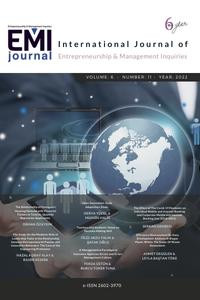Abstract
Bu çalışma Chesbrough and Brunswicker (2013) tarafından geliştirilip kullanılan ve Roman Teplov (2018) tarafından yeniden düzenlenen açık inovasyon ölçeğinin inovasyon süreçleri dikkate alınarak Türkçe’ye uyarlanmasını kapsamaktadır. Çalışmada öncelikle inovasyon süreçleri dikkate alınarak açık inovasyon kavramı ve boyutları anlam ve içerik olarak açıklanmış sonrasında da ölçek uyarlama çalışmasına yer verilmiştir.
Bu amaçla işletme alanında açık inovasyon faaliyetlerini esas alan ölçek, katılımcıların çalıştıkları işletmede açık inovasyon uygulama düzeyinin değerlendirilmesi amacıyla kullanılmak üzere Türkçeye uyarlanmıştır. Önce test çalışmaları yapılan ölçek daha sonra 579 katılımcının yer aldığı örneklemden toplanan veriler üzerinde geçerlik ve güvenilirlik analizlerine tabi tutulmuştur. Ölçeğe ilişkin yapısal geçerliğin belirlenmesi amacıyla Doğrulayıcı Faktör Analizi (DFA) kullanılarak iki boyutlu faktör yapısı literatüre uygun şekilde doğrulanmıştır. PLS-SEM ortamında yapılan analizler sonucunda ölçeğin, çalışmanın gerçekleştirildiği örneklem açısından geçerli ve güvenilir bir ölçek olduğu sonucuna ulaşılmıştır.
References
- Abulrub, A. G. & Lee, J. (2012). Open innovation management: challenges and prospects. International Conference on Leadership, Technology and Innovation Management, Procedia - Social and Behavioral Sciences, 41, 130-138.
- Almeida, F. (2021). Open-Innovation Practices: Diversity in Portuguese SMEs. Journal of Open Innovation: Technology, Market, and Complexity, 7(3), 169. MDPI AG. Retrieved from http://dx.doi.org/10.3390/joitmc7030169
- Bianchi, M., Cavaliere, A., Chiaroni, D., Frattini, F., & Chiesa, V. (2011). Organisational Modes for Open Innovation in the Bio-Pharmaceutical Industry: An Exploratory Analysis. Technovation, 31, 22–33. https://doi.org/10.1016/j.technovation.2010.03.002
- Chesbrough, H. (2003). Open Innovation: The New Imperative for Creating and Profiting From Technology, Boston, Massachusetts: Harvard Business School Press.
- Chesbrough, H. (2006). Open Innovation: A New Paradigm for Understanding Industrial Innovation. Open Innovation Researching A New Paradigm, Ed. Henry Chesbrough, Wim Vanhaverbeke ve Joel West, 1-12, UK: Oxford University Press.
- Chesbrough, H. (2011). The Era of Open Innovation. MITSloan Management Review, Sloanselect Collection Winter 2011, 35-41.
- Chesbrough, H. & Brunswicker, S. (2013). Managing open innovation in large firms. Berkeley, CA: Fraunhofer Verlag.
- Chesbrough, H. & Crowther, A. K. (2006). Beyond high tech: early adopters of open innovation in other industries. R&D Management, 36: 229-236. doi:10.1111/j.1467-9310.2006.00428.x
- Enkel, E., Gassmann, O. & Chesbrough, H. (2009). Open R&D and Open Innovation: Exploring the Phenomenon. R&D Management, 39, 311-316. 10.1111/j.1467-9310.2009.00570.x.
- Felin, T. & Zenger, T. (2014). Closed or Open Innovation? Problem Solving and the Governance Choice. Research Policy, 43, 914-925.
- Gassmann, O. & Enkel, E. (2004). Towards a Theory of Open Innovation: Three Core Process Archetypes. R&D Management Conference (RADMA) 2004, Lissabon.
- Hair, J. F., Hult, G. T. M., Ringle, C. M. & Sarstedt, M. (2017). A Primer on Partial Least Squares Structural Equation Modeling (PLS-SEM). (Second Edition) Thousand Oaks: Sage.
- Henseler, J., Hubona G. S. & Ray, P. A. (2016). Using PLS path modeling in new technology: Updated guidelines. Industrial Management & Data Systems, 116, 1-19.
- Huizingh, E.K. (2011). Open innovation: State of the art and future perspectives. Technovation, 31, 2-9.
- Kline, P. (1994). An Easy Guide To Factor Analysis. New York: Routledge.
- Kline, R. B. (2005). Principles and practice of structural equation modeling. 2nd Edt., New York, NY: Guilford
- Rufat‐Latre, J., Muller, A. & Jones, D. (2010), "Delivering on the promise of open innovation", Strategy & Leadership, Vol. 38 No. 6, pp. 23-28. https://doi.org/10.1108/10878571011088032
- Spithoven, A., Vanhaverbeke, W., & Roijakkers, N. (2013). Open innovation practices in SMEs and large enterprises. SMALL BUSINESS ECONOMICS, 41(3), 537–562.
- Tabachnick, B. & Fidell, L. (2018). Using Multivariate Statistics. 6th Edt., Boston, MA: Pearson Education Inc.
- Teplov, R. (2018). A holistic approach to measuring open innovation: contribution to theory development. (Yayınlanmamış Doktora Tezi). Lappeenranta University of Technology.
- Xie, X., & Wang, H. (2020). How can open innovation ecosystem modes push product innovation forward? An fsQCA analysis. Journal of Business Research, 108, 29-41.
Abstract
This study covers the adaptation studies of the open innovation scale developed and used by Chesbrough and Brunswicker (2013) and rearranged by Roman Teplov (2018), taking into account the innovation processes. In the study, first of all, considering the innovation processes, the concept of open innovation and its dimensions were explained as meaning and content, and then scale adaptation study was included.
For this purpose, the scale, which is based on open innovation activities in the field of business, was adapted into Turkish to be used in order to evaluate the level of open innovation implementation in the enterprises where the participants work. The scale, which was tested first, was then subjected to validity and reliability analyzes on the data collected from the sample of 579 participants. In order to determine the structural validity of the scale, the two-dimensional factor structure was verified in accordance with the literature by using Confirmatory Factor Analysis (CFA). As a result of the analyzes made in the PLS-SEM environment, it was concluded that the scale is a valid and reliable scale for the sample in which the study was conducted.
References
- Abulrub, A. G. & Lee, J. (2012). Open innovation management: challenges and prospects. International Conference on Leadership, Technology and Innovation Management, Procedia - Social and Behavioral Sciences, 41, 130-138.
- Almeida, F. (2021). Open-Innovation Practices: Diversity in Portuguese SMEs. Journal of Open Innovation: Technology, Market, and Complexity, 7(3), 169. MDPI AG. Retrieved from http://dx.doi.org/10.3390/joitmc7030169
- Bianchi, M., Cavaliere, A., Chiaroni, D., Frattini, F., & Chiesa, V. (2011). Organisational Modes for Open Innovation in the Bio-Pharmaceutical Industry: An Exploratory Analysis. Technovation, 31, 22–33. https://doi.org/10.1016/j.technovation.2010.03.002
- Chesbrough, H. (2003). Open Innovation: The New Imperative for Creating and Profiting From Technology, Boston, Massachusetts: Harvard Business School Press.
- Chesbrough, H. (2006). Open Innovation: A New Paradigm for Understanding Industrial Innovation. Open Innovation Researching A New Paradigm, Ed. Henry Chesbrough, Wim Vanhaverbeke ve Joel West, 1-12, UK: Oxford University Press.
- Chesbrough, H. (2011). The Era of Open Innovation. MITSloan Management Review, Sloanselect Collection Winter 2011, 35-41.
- Chesbrough, H. & Brunswicker, S. (2013). Managing open innovation in large firms. Berkeley, CA: Fraunhofer Verlag.
- Chesbrough, H. & Crowther, A. K. (2006). Beyond high tech: early adopters of open innovation in other industries. R&D Management, 36: 229-236. doi:10.1111/j.1467-9310.2006.00428.x
- Enkel, E., Gassmann, O. & Chesbrough, H. (2009). Open R&D and Open Innovation: Exploring the Phenomenon. R&D Management, 39, 311-316. 10.1111/j.1467-9310.2009.00570.x.
- Felin, T. & Zenger, T. (2014). Closed or Open Innovation? Problem Solving and the Governance Choice. Research Policy, 43, 914-925.
- Gassmann, O. & Enkel, E. (2004). Towards a Theory of Open Innovation: Three Core Process Archetypes. R&D Management Conference (RADMA) 2004, Lissabon.
- Hair, J. F., Hult, G. T. M., Ringle, C. M. & Sarstedt, M. (2017). A Primer on Partial Least Squares Structural Equation Modeling (PLS-SEM). (Second Edition) Thousand Oaks: Sage.
- Henseler, J., Hubona G. S. & Ray, P. A. (2016). Using PLS path modeling in new technology: Updated guidelines. Industrial Management & Data Systems, 116, 1-19.
- Huizingh, E.K. (2011). Open innovation: State of the art and future perspectives. Technovation, 31, 2-9.
- Kline, P. (1994). An Easy Guide To Factor Analysis. New York: Routledge.
- Kline, R. B. (2005). Principles and practice of structural equation modeling. 2nd Edt., New York, NY: Guilford
- Rufat‐Latre, J., Muller, A. & Jones, D. (2010), "Delivering on the promise of open innovation", Strategy & Leadership, Vol. 38 No. 6, pp. 23-28. https://doi.org/10.1108/10878571011088032
- Spithoven, A., Vanhaverbeke, W., & Roijakkers, N. (2013). Open innovation practices in SMEs and large enterprises. SMALL BUSINESS ECONOMICS, 41(3), 537–562.
- Tabachnick, B. & Fidell, L. (2018). Using Multivariate Statistics. 6th Edt., Boston, MA: Pearson Education Inc.
- Teplov, R. (2018). A holistic approach to measuring open innovation: contribution to theory development. (Yayınlanmamış Doktora Tezi). Lappeenranta University of Technology.
- Xie, X., & Wang, H. (2020). How can open innovation ecosystem modes push product innovation forward? An fsQCA analysis. Journal of Business Research, 108, 29-41.
Details
| Primary Language | Turkish |
|---|---|
| Subjects | Business Administration |
| Journal Section | Articles |
| Authors | |
| Publication Date | December 30, 2022 |
| Submission Date | July 25, 2022 |
| Acceptance Date | December 16, 2022 |
| Published in Issue | Year 2022 Volume: 6 Issue: 11 |



Journal EMI e-mail Adresi: internationaljournalemi@gmail.com
JOURNAL EMI Creative Commons Attribution 4.0 Uluslararası Lisansı ile lisanslanmıştır.


